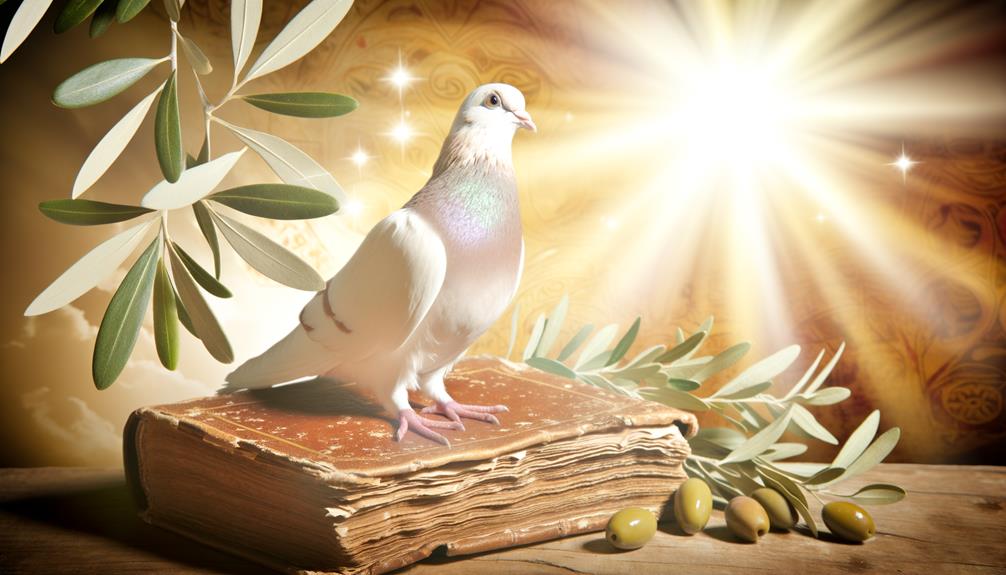Meaning Of Pigeons In The Bible: Sacrifice Symbolism
In the Bible, pigeons symbolize purity, peace, and divine presence. They are associated with spiritual innocence and the Holy Spirit, especially in the baptism of Jesus (Matthew 3:16).
In the Old Covenant, pigeons serve as sacrificial offerings accessible to the poor, emphasizing humility and covenantal faithfulness (Leviticus 5:7). The narrative of Noah also uses a pigeon to signal hope and renewal (Genesis 8:8-12).
Their role extends to being a symbol of divine approval and redemption. This multifaceted symbolism highlights deep theological meanings, which can be further enriched by understanding their broader cultural and scriptural contexts.

Meaning of Pigeons in the Bible: Symbol of Purity, Sacrifice, and Peace
| Aspect | Description |
|---|---|
| Symbolic Meaning | Purity, innocence, peace, humility |
| Common Usage | Sacrificial offering, especially for the poor (Leviticus 1:14; Luke 2:24) |
| Biblical Reference | Leviticus 1:14-17, Leviticus 12:8, Luke 2:24 |
| Role in Sacrifice | Alternative to lambs for those with limited means |
| Associated Virtues | Simplicity, gentleness, faithfulness |
| New Testament Usage | Used during Jesus’ dedication at the temple (Luke 2:22-24) |
| Spiritual Symbolism | Inner peace, divine provision, God’s acceptance |
Symbolism of Pigeons

In biblical texts, pigeons, often referred to as doves, are imbued with profound symbolic meanings that encompass themes of purity, peace, and divine presence.
The dove’s association with the Holy Spirit, as seen in the New Covenant’s account of Jesus’ baptism (Matthew 3:16), underscores its role as a divine messenger.
Additionally, the dove’s portrayal in Noah’s narrative (Genesis 8:8-12) symbolizes hope and the renewal of life post-Deluge. Historically, pigeons were accessible sacrificial offerings, representing humility and devotion (Leviticus 5:7).
Theologically, these birds embody innocence and the aspiration towards spiritual purity.
This multifaceted symbolism has cemented pigeons as enduring icons within Christian iconography, reflecting their integral place in biblical allegory and ritual practice.
Pigeons in Old Testament

Old Covenant scriptures frequently highlight pigeons as significant elements in various religious rites and covenantal narratives.
Within the Levitical law, pigeons were often prescribed as offerings for those who could not afford more costly sacrifices like lambs (Leviticus 5:7). This provision underscores the inclusivity of God’s covenant, allowing even the impoverished to participate in sacred rituals.
Additionally, pigeons symbolized purity and humility, qualities essential to Old Scriptures sacrificial practices. In Genesis 15:9, God commands Abram to present a pigeon among other animals in the covenantal ceremony, signifying divine promise and human faithfulness.
These references illustrate pigeons’ multifaceted role in embodying religious devotion, covenantal relationship, and socio-economic considerations within the spiritual framework of ancient Israel.
Pigeons in New Testament

In the New Scriptures, pigeons are imbued with profound theological significance, prominently symbolizing the Holy Spirit, as seen in the baptism of Jesus (Matthew 3:16).
Additionally, pigeons continue to serve as offerings and sacrifices, reflecting continuity with Old Scriptures practices but within a renewed covenantal context (Luke 2:24).
This dual role underscores their enduring spiritual and ritualistic import in early Christian tradition.
Symbol of Holy Spirit
The New Scripture frequently portrays pigeons as a profound symbol of the Holy Spirit, especially during the baptism of Jesus where the Spirit descends like a dove.
This pivotal event, recorded in all four Gospels (Matthew 3:16, Mark 1:10, Luke 3:22, John 1:32), signifies the commencement of Jesus’ earthly ministry and the divine approval of His mission.
The dove, embodying purity and peace, encapsulates the essence of the Holy Spirit’s role in guiding and sanctifying believers.
Historically, the imagery of a dove descending harkens back to Old Covenant symbols of divine presence and favor.
Consequently, the New Covenant use of pigeons as a representation of the Holy Spirit is both a continuation and fulfillment of scriptural motifs.
Offerings and Sacrifices
Beyond symbolizing the Holy Spirit, pigeons also serve a significant role in the New Scripture as offerings and sacrifices, reflecting ancient Jewish purification practices and the socioeconomic realities of early Christian communities. In Luke 2:24, Mary and Joseph offer two pigeons at the Temple for Mary’s purification, adhering to Levitical law (Leviticus 12:8).
This act underscores their humble status and commitment to religious law. The offering of pigeons signifies accessibility for the poor, who could not afford larger animals. Therefore, pigeons embody both a theological symbol and a practical provision for worship.
| Scriptural Reference | Event | Significance |
|---|---|---|
| Luke 2:24 | Mary’s purification offering | Compliance with Levitical law |
| Leviticus 12:8 | Law on purification offerings | Provision for the economically humble |
| Matthew 10:29 | Sparrows’ worth | Divine care for the humble |
| Mark 11:15 | Cleansing of the Temple | Critique of economic exploitation |
Pigeons as Sacrificial Offerings

The use of pigeons as sacrificial offerings in the Bible underscores their role in symbolizing ritual purity and atonement.
Scriptural references, such as in Leviticus and Luke, illustrate their importance in sacrificial practices, particularly for those unable to afford larger animals.
Historically, pigeons also played a significant role in Temple worship, reflecting broader socio-religious dynamics within ancient Israelite society.
Symbolic Ritual Purity
Integral to ancient Israelite religious practices, pigeons served as significant sacrificial offerings symbolizing ritual purity and atonement in various biblical passages.
These small birds were often prescribed for those unable to afford more costly sacrifices, consequently embodying the inclusiveness of divine forgiveness.
Levitical laws, particularly in Leviticus 12:8 and 14:22, detail the use of pigeons in purification rites, underscoring their role in restoring individuals to a state of holiness.
The offering of pigeons not only facilitated atonement for sin but also maintained the ritual purity essential for communal worship.
This practice reflects a theology that values both the accessibility of redemption and the meticulous observance of divine law, ensuring a holistic approach to spiritual cleanliness.
Biblical Sacrifice Examples
Within the biblical narrative, pigeons are frequently cited as sacrificial offerings, exemplifying the divine provision for atonement and purification in both individual and communal contexts.
Leviticus 12:8 underscores their use as an accessible alternative for those unable to afford a lamb, signifying God’s inclusive covenant.
In Luke 2:24, Mary and Joseph’s offering of pigeons during Jesus’ Presentation at the Temple echoes this tradition, highlighting their socioeconomic status and adherence to Mosaic Law.
Pigeons, therefore, symbolize humility and divine mercy.
The Book of Numbers (6:10) further elucidates their role in Nazirite vows, where they serve to restore ritual purity.
Such instances illustrate pigeons as integral to the sacrificial system, reflecting theological principles of repentance and reconciliation.
Pigeons in Temple Worship
In the context of Temple worship, pigeons served not only as accessible offerings for sacrificial rites but also as profound symbols of purity and divine acceptance for the penitent.
Levitical laws, particularly in Leviticus 12:8, permitted pigeons as a substitute for more costly sacrifices, ensuring inclusivity for the economically disadvantaged. This provision underscored the equitable nature of God’s covenant, emphasizing that atonement and purification were available to all, regardless of social status.
Historically, pigeons were integral in rites of purification and thanksgiving, as seen in Luke 2:24 with Mary’s offering at Jesus’ presentation.
Theologically, their use signified a contrite heart and the universal need for reconciliation, reflecting broader themes of equity and divine mercy within Judaic worship practices.
Pigeons and the Holy Spirit

The symbolic association of pigeons with the Holy Spirit is profoundly illustrated in the New Covenant, particularly in the account of Jesus’ baptism where the Spirit descends upon Him in the form of a dove. This imagery is rich in theological significance, encapsulating purity, peace, and divine presence.
The dove, akin to a pigeon, becomes a visual representation of the Holy Spirit’s gentle and transformative nature. This event, recorded in the Gospels, underscores the shift from old to new, emphasizing the fulfillment of prophetic promises.
| Scriptural Reference | Symbolism | Theological Insight |
|---|---|---|
| Matthew 3:16 | Dove | Divine approval of Jesus |
| Mark 1:10 | Dove | Holy Spirit’s presence |
| Luke 3:22 | Dove | Manifestation of grace |
| John 1:32 | Dove | Spiritual anointment |
This scriptural account invites believers to reflect on the profound significance of the Holy Spirit’s role in the Christian faith.
Cultural Significance of Pigeons

Throughout various cultures and historical periods, pigeons have been imbued with rich symbolic meanings and have held significant roles in religious rituals and daily life.
In ancient Mesopotamia, pigeons were associated with the goddess Ishtar, symbolizing fertility and love. In Greco-Roman traditions, they were sacred to Aphrodite and Venus, representing affection and devotion.
Biblically, pigeons are frequently mentioned, especially in sacrificial contexts within Levitical law, where they symbolized purity and atonement for sin (Leviticus 1:14-17). Their role as messengers, both divine and mundane, underscores their significance in communication and covenant.
Additionally, in Christian iconography, the dove, a close relative, embodies the Holy Spirit, emphasizing peace, purity, and divine presence.
Consequently, pigeons encapsulate profound theological and cultural resonances.
Conclusion
In biblical texts, pigeons emerge as symbols of purity, simplicity, and divine presence.
In the Old Covenant, pigeons serve as sacrificial offerings, embodying humility and devotion. In the New Covenant, pigeons signify the Holy Spirit, underscoring divine intervention.
The sacrificial role of pigeons reflects a deeper theological narrative, while their association with the Holy Spirit emphasizes spiritual renewal.
Consequently, pigeons in scripture encapsulate purity, sacrifice, and divine connection, enriching theological and cultural understanding.






